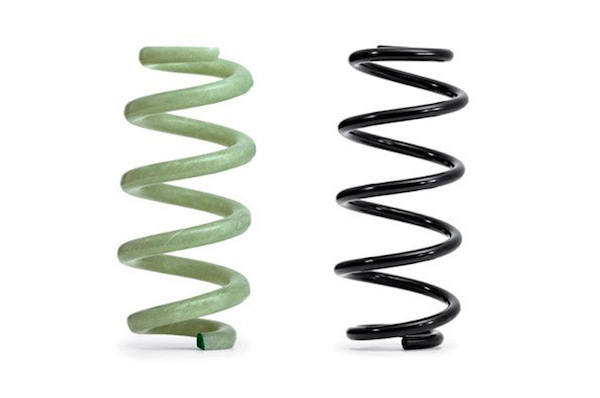
[Image above] The Audi A6 is reportedly going on a diet in a new lightweighting strategy that replaces steel with glass. Credit: Raptor Alpha; Flickr CC BY-ND 2.0
The cars of the future can’t yet fly, but they are getting lighter—a trend referred to as “lightweighting”—thanks to governmental standards that aim to increase fuel efficiency to 54.5 mpg by model year 2025.
Audi recently announced its own lightweighting strategy to put some of its models on a diet that will trim almost 10 pounds, from a perhaps unlikely source.

New glass fiber-reinforced composite springs (left) are greener—literally—than steel springs (right).
The German automobile manufacturer says that traditional steel suspension system springs are out—and lightweight composite springs are in. The new glass fiber-reinforced polymer composite will save about 2.5 lbs per spring, a 40% weight reduction over steel springs.
To make these tough-but-light springs, Audi forms the coils with twisted glass fibers embedded in epoxy resin. Before heat curing, the springs are wrapped with more glass fibers, positioned at 45-degree angles from the longitudinal axis, for maximum strength.
According to a Motor Authority article, Audi thinks the final springs are just as durable and reliable as steel springs. (Does that mean they actually tested them, or they just have a good hunch?)
Besides the savings in poundage, which equates to increased fuel efficiency, the composite springs won’t corrode like steel springs, are produced with less energy than steel springs, and improve the car’s overall driving precision and handling, according to Audi.
Which lucky recipient will first see the new springs? “Based on prototypes seen testing in Europe, the first recipient is expected to be the upcoming Audi A6,” Kelley Blue Book speculates.
In other automotive news, have you seen Toyota’s recently unveiled fuel-cell vehicle, FCV? Expected to go on sale in California in about a year, the sleek car has a 300-mile range on a five-minute hydrogen fill-up, according to Consumer Reports.
